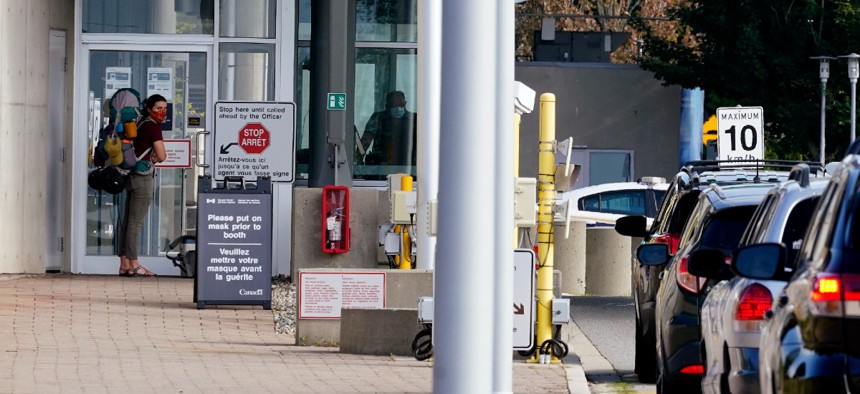Thermal Body Scans Being Tested at Pedestrian Border Crossings

Elaine Thompson Elaine Thompson/AP
Customs and Border Protection is piloting the Pedestrian Detection-at-Range system to identify illegal or dangerous items being smuggled through ports of entry.
International travelers moving through certain ports of entry on foot will be subject to passive thermal scanning as part of a technology demonstration testing a new ranged nonintrusive inspection system for pedestrian traffic.
The Customs and Border Protection agency is piloting body scanning technologies at pedestrian border crossings to detect weapons and other contraband moving through ports of entry without having to stop every person in line for a physical search.
The new Pedestrian Detection-at-Range system will take video and photo images of travelers, then overlay those images with thermal scans looking for items hidden under clothing. Suspicious scans will lead to secondary physical searches and maintained as evidence for any potential criminal actions, according to a privacy impact assessment.
Non-intrusive scanning technologies have been in use at ports of entry for some time, mostly to search vehicles, shipping containers, parcels and other baggage as they move through the border checkpoints. The scans allow CBP officers to keep lines and goods moving while picking out suspicious items for additional searches.
The detection-at-range system for pedestrian entry will work the same way.
Currently, CBP officers “employ a variety of techniques to determine whether to conduct a personal search, including behavioral analysis and observable techniques involving recognizing discrepancies like unnatural gait and unexplained bulges in clothing,” the privacy assessment states. The new system will add to those methods by allowing CBP security personnel at ports of entry to review data from the detection-at-range system and use that to determine whether follow-up physical inspections are warranted.
The impact assessment notes similar “non-invasive, passive scanning technologies” are used as part of security measures at airports and within federal buildings.
The new system is getting a trial run at five ports of entry: Port of Nogales, Arizona, and San Ysidro, Otay Mesa, Cross Border Express and Tecate border crossings in California. The agency also has plans to expand the program to Miami International Airport, New York JFK International Airport, Fort Lauderdale cruise ship terminal and Detroit, Michigan.
The initial technology demonstration is slated to run for 30 days.
The technology solution being tested looks for anomalies in travelers’ body heat to show any potential liquids or solids that might be hidden beneath someone’s clothing.
“The reviewing officer may identify the absence of emitted thermal energy that may represent solid or liquid objects with known shapes, such as a weapon, or amorphous shapes, such as radiological material, explosives, or other contraband,” the document states.
The privacy impact statement notes the technology is passive, “meaning that it does not emit energy like x-ray or other radio frequency waves and cannot see objects concealed inside the body.”
The system as it is currently designed offers three types of data collection: always record; record on demand, referred to as “snapback;” and never record.
“For this technology demonstration, CBP will only use the snapback feature and record on demand,” the impact assessment states. “Images and videos of individuals who do not meet this threshold—i.e., a negative result—are not recorded or retained.”
If the secondary physical search results in detention and law enforcement action, the video recordings and still images will be saved to a CD or removeable storage device and transferred to the agency’s case and evidence tracking systems. The original data will then be deleted from the detection-at-range system.
“No personally identifiable information will be entered by Customs and Border Protection officers into the Pedestrian Detection-at-Rage system,” the document states, adding that if the pilots fail and the program is abandoned, all associated “laptops will be erased and disposed of per current procedures.”
For the time being, travelers can opt out of the detection-at-range scans and default to previous inspection methods.
“Pedestrians who choose not to be scanned remain subject to all other authorized processes such as baggage inspection, roving canine operations or personal search,” the impact assessment states.
CBP officials said travelers will “be provided a meaningful opportunity” to opt out, including signs posted in English and Spanish and factsheets available upon request.

NEXT STORY: ‘Moms for Liberty’ Group Sets Sights on Local Government






